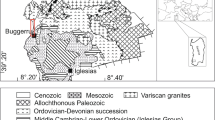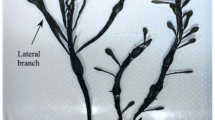Abstract
Autometallography (AMG) and electron probe X-ray microanalysis (EPXMA) were applied in combination to determine the subcellular distribution of Cd and its subcellular ligands in the digestive gland cells of Cd-exposed mussels Mytilus galloprovincialis. Black silver deposits (BSD), which reveal the presence of metals when AMG is applied, were only localized in digestive cell lysosomes. Digestive cell cytoplasm and basophilic cells were devoid of BSD. EPXMA (static probe and X-ray mapping) indicated that Cd, S (possibly associated with metallothioneins or metallothionein-like proteins) and autometallographical Ag ions are co-localized within digestive cell lysosomes. In addition, Cd and S co-occur in the absence of Ag in the cytosol of digestive cells. AMG does not reveal the presence of the Cd ‘pool’ strongly bound to cytosolic Cd-metallothionein complexes; only ‘free’ Cd or Cd supposedly loosely bound to (semi)digested metallothionein within lysosomes was revealed. The levels of lysosomal Cd were indirectly quantified by stereology as the volume density of BSD (VvBSD). Significantly higher values were recorded in Cd-exposed mussels compared with controls at all exposure times. However, VvBSD values were lower at days 7 and 21 than at day 1. This relative decrease in VvBSD reflected another (and confounding) response elicited by Cd-exposure in the digestive epithelium: the volume density of basophilic cells (VvBAS) increased significantly as exposure progressed. Due to this cell-type replacement, the net accumulative capacity of the digestive epithelium decreases at long exposure times.
Similar content being viewed by others
References
Bustamante P, Cosson RP, Gallien I, Caurant F, Miramand P (2002) Cadmium detoxification processes in the digestive gland of cephalopods in relation to accumulated cadmium concentrations. Mar Environ Res 53: 227–241.
Cajaraville MP, Díez G, Marigómez I, Angulo E (1990a) Responses of basophilic cells of the digestive gland of mussels to petroleum hydrocarbon exposure. Dis Aquat Org 9: 221–228.
Cajaraville MP, Marigómez I, Angulo E (1990b) Short-term toxic effects of 1-naphthol on the digestive gland-gonad complex of the marine prosobranch Littorina littorea (L.): A light microscopic study. Arch Environ Contam Toxicol 19: 17–24.
Cajaraville MP, Robledo Y, Etxeberria M, Marigómez I (1995) Cellular biomarkers as useful tools in the biological monitoring of pollution: Molluscan digestive lysosomes. In: Cajaraville MP, ed. Cell Biology in Environmental Toxicology. Bilbao: University of the Basque Country Press Service, pp. 29–55.
Dallinger R (1995) Mechanisms of metal incorporation into cells. In: Cajaraville MP, ed. Cell Biology in Environmental Toxicology. Bilbao: University of the Basque Country Press Service, pp. 133–154.
Danscher G (1984) Autometallography. A new technique for light and electron microscopic visualization of metals in biological tissues (gold, silver, metal sulphides and metal selenides). Histochemistry 81: 331–335.
Da Ros L, Nasci C, Marigómez I, Soto M (2000) Biomarkers and trace metals in digestive gland of indigenous and transplanted mussels, Mytilus galloprovincialis, in Venice lagoon, Italy. Mar Environ Res 50: 417–423.
Domouhtsidou GP, Dimitriadis VK (2000) Ultrastructural localization of heavy metals (Hg, Ag, Pb, and Cu) in gills and digestive gland of mussels, Mytilus galloprovincialis (L.). Arch Environ Contam Toxicol 38: 472–478.
Giamberini L, Auffret M, Pihan JC (1996) Hemocytes of the freshwater mussel, Dreissena polymorpha Pallas: Cytology, cytochemistry and X-ray microanalysis. J Moll Stud 62: 367–379.
Hemelraad J, Herwig HJ (1988) Cadmium kinetics in freshwater clams. IV. Histochemical localization of cadmium in Anodonta cygnea and Anodonta anatina exposed to cadmium chloride. Arch Environ Contam Toxicol 17: 337–343.
Herwig HJ, Brands F, Kruitwagen E, Zandee DI (1989) Bioaccumulation and histochemical localization of cadmium in Dreissena polymorpha exposed to cadmium chloride. Aquat Toxicol 15: 269–286.
Holwerda DA (1991) Cadmium kinetics in freshwater clams. V. Cadmium-copper interaction in metal accumulation by Anodonta cygnea and characterization of the metal-binding protein. Arch Environ Contam Toxicol 21: 432–437.
Isani G, Andreani G, Kindt M, Carpene E (2000) Metallothioneins (MTs) in marine molluscs. Cell Mol Biol 46: 311–330.
Kägi JHR, Schäffer A (1988) Biochemistry of metallothioneins. Biochemistry 27: 8509–8515.
Langston WJ, Bebianno MJ, Burt GB (1998) Metal handling strategies in molluscs. In: Langston WJ, Bebianno MJ, eds. Metal Metabolism in Aquatic Envionments. London: Chapman & Hall, pp. 219–283.
Lowe DM, Moore MN, Clarke KR (1981) Effects of oil on digestive cells in mussels: Quantitative alterations in cellular and lysosomal structure. Aquat Toxicol 8: 265–272.
Mackay EA, Overnell J, Dunbar B, Davidson I, Hunziker PE, Kägi JH, Fotherhill JE (1993) Complete aminoacid sequences of five dimeric and four monomeric forms of metallothionein from the edible mussel Mytilus edulis. Eur J Biochem 218: 183–194.
Marigőmez I, Cajaraville MP, Angulo E (1990a) Cellular distribution of cadmium in the common winkle Littorina littorea (L.) determined by X-ray microprobe analysis and histochemistry. Histochemistry 94: 191–199.
Marigőmez I, Cajaraville MP, Angulo E (1990b) Histopathology of the digestive gland-gonad complex of the marine prosobranch Littorina littorea exposed to cadmium. Dis Aquat Org 9: 229–238.
Marigőmez I, Soto M, Kortabitarte M (1996) Tissue-level biomarkers of biological effect of mercury on sentinel slugs, Arion ater. Arch Environ Contam Toxicol 31: 54–62.
Marigőmez I, Kortabitarte M, Dussart GBJ (1997) Tissue-level biomarkers in sentinel slugs as cost-effective tools to assess metal pollution in soils. Arch Environ Contam Toxicol 34: 167–176.
Marigőmez I, Cajaraville MP, Soto M, Lekube X (1998) Cell-type replacement, a successful strategy of molluscs to adapt to chronic exposure to pollutants. Cuad Invest Biol 20: 411–414.
Marigőmez I, Soto M, Cajaraville MP, Angulo E, Giamberini L (2002) Cellular and subcellular distribution of metals in molluscs. Microsc Res Tech 56: 358–392.
Martoja R, Martoja-Pierson M (1970) T´ecnicas de Histolog´?a Animal. Barcelona: Toray Masson.
Mason AZ, Simkiss K (1983) Interactions between metals and their distribution in tissues of Littorina littorea (L.) collected from clean and polluted sites. J Mar Biol Ass UK 63: 661–672.
Mason AZ, Jenkins KD (1995) Metal detoxification in aquatic organisms. In: Tessier A, Turner DR, eds. Metal Speciation and Bioavailability in Aquatic Systems. New York: John Wiley and Sons, pp. 479–608.
Mason AZ, Simkiss K, Ryan KP (1984) The ultrastructural localization of metals in specimens of Littorina littorea collected from clean and polluted sites. J Mar Biol Ass UK 64: 699–720.
Morgan AJ, Winters C, StÜrzebaum S (1997) X-ray microanalysis techniques. In: Hajibagheri N, ed. Methods in Molecular Medicine Biology. Vol. 117, Electron Microscopy Methods and Protocols. Totowa NJ: Humana Press Inc., pp. 245–276.
Pavicic S, Balestreri E, Lenzi P, Raspor B, Branica MF (1991) Isolation and partial characterization of cadmium induced metallothionein-like proteins in Mytilus galloprovincialis. Mar Chem 36: 249–265.
Pearse AGE (1980) Histochemistry. Theoretical and Applied. Vol. 1, Preparative and Optical Technology. 4th edn. Edinburgh: Churchill Livingstone.
Porte C, Sole M, Borgi V, Martínez M, Chamorro J, Torreblanca A, Ortiz-Zarragoitia M, Orbea A, Soto M, Cajaraville MP (2001) Chemical, biochemical and cellular responses in digestive gland of mussels Mytilus galloprovincialis from the Spanish Mediterranean coast. Biomarkers 6: 335–350.
Rainbow PS, Dallinger R (1993) Metal uptake, regulation and excretion in freshwater invertebrates. In: Dallinger R, Rainbow PS, eds, Ecotoxicology of Metals in Invertebrates. Boca Raton, Florida: Lewis Publ., pp. 119–131.
Roesijadi G (1994) Metallothionein induction as a measure of response to metal exposure in aquatic animals. Environ Health Persp 102(Suppl. 12): 91–95.
Roesijadi G (2000) Metal transfer as a mechanism for metallothioneinmediated metal detoxification. Cell Mol Biol 46: 393–405.
Sokal RR, Rohlf FJ (1979) Biometría. Madrid: Blume.
Soto M, Marigómez I (1997a) BSD extent, an index for metal pollution screening based on the metal content within digestive cell lysosomes of mussels as determined by autometallography. Ecotoxicol Environ Safety 37: 141–151.
Soto M, Marigómez I (1997b) Metal bioavailability assessment in ‘Mussel-Watch’ programmes by automated image analysis of BSD in digestive cell lysosomes. Mar Ecol Prog Ser 156: 141–150.
Soto M, Cajaraville MP, Angulo E, Marigómez I (1996a) Autometallographic localization of protein-bound copper and zinc in the common winkle, Littorina littorea: A light microscopical study. Histochem J 28: 1–13.
Soto M, Cajaraville MP, Marigómez I (1996b) Tissue and cell distribution of copper, zinc and cadmium in the mussel Mytilus galloprovincialis determined by autometallography. Tissue Cell 28: 557–568.
Soto M, Quincoces I, Lekube X, Marigómez I (1998a) Autometallographed metal content in digestive cells of winkles: A cost-effective screening tool to monitor Cu and Zn pollution. Aquat Toxicol 40: 123–140.
Soto M, Quincoces I, Marigómez I (1998b) Autometallographical procedure for the localization of metal traces in molluscan tissues by light-microscopy. J Histotechnol 21: 123–127.
Taylor MG(1995) Mechanisms of metal immobilization and transport in cells. In: Cajaraville MP, ed. Cell Biology in Environmental Toxicology. Bilbao: University of the Basque Country Press Service, pp. 155–170.
Viarengo A (1989) Heavy metals in marine invertebrates: Mechanisms of regulation and toxicity at the cellular level. Rev Aquat Sci 1: 295–317.
Viarengo A, Nott JA (1993) Mechanisms of heavy metal cation homeostasis in marine invertebrates. Comp Biochem Physiol 103: 355–372.
Viarengo A, Canesi L, Mazzucotelli A, Ponzano E (1993) Cu, Zn and Cd content in different tissues of the Antarctic scallop Adamussium colbecki, role of metallothionein in heavy metal homeostasis and detoxification. Mar Ecol Prog Ser 95: 163–168.
Weibel ER (1979) Stereological Methods. Vol. 1, London: Academic Press.
Author information
Authors and Affiliations
Rights and permissions
About this article
Cite this article
Soto, M., Zaldibar, B., Cancio, I. et al. Subcellular Distribution of Cadmium and its Cellular Ligands in Mussel Digestive Gland Cells as Revealed by Combined Autometallography and X-ray Microprobe Analysis. Histochem J 34, 273–280 (2002). https://doi.org/10.1023/A:1023322423654
Issue Date:
DOI: https://doi.org/10.1023/A:1023322423654




